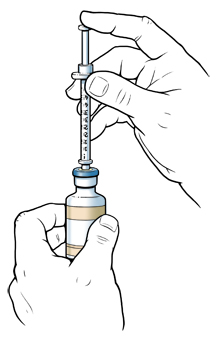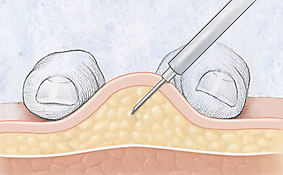Giving a Subcutaneous (Sub-Q) Injection, 1 Medicine
Your health care provider has prescribed a medicine that you can give yourself using a needle. This is called a subcutaneous injection, or sub-Q injection. This means putting the medicine into the fatty areas just under your skin (subcutaneous tissue). The needle used for a sub-Q injection is very small. It doesn't cause much pain. Many medicines are given in this way.
Your provider has prescribed the amount and times you need to give yourself the medicine.
The name of my medicine is: ______________________
Amount for each injection: ____________________________
Times per day: _________________________________
Number of days to give injection: _________________________
Home care
Follow these guidelines when caring for yourself at home.
Get your work area ready
-
Put any pets in another room.
-
Wash your hands for 1 to 2 minutes with soap and clean water. Liquid soap is best.
-
Clean your area with soap and water. Dry it with a paper towel.
Gather these items
-
You'll need your medicine. Keep in mind that some medicine vials must be taken out of the refrigerator for a specific amount of time before you inject them. Read the label and follow the instructions.
-
Make sure you have a sterile disposable syringe. Don’t reuse your syringes.
-
You'll need alcohol wipes or swabs.
-
Make sure you have a special container to throw out the used syringe (sharps container). You can buy a sharps container at a pharmacy or medical supply store. You can also use an empty laundry detergent bottle, or any other puncture-proof container and lid.
Then wash your hands again.
Choose your injection site
 |
| Injection sites. |
You may find that the easiest and safest places to inject medicine are these areas:
Keep these in mind:
-
Stay away from areas that are red, swollen, or bruised.
-
Don't inject in the same site 2 times in a row. Choose a site that is at least 2 inches away from your last injection site.
Get the medicine ready

Check the medicine in the vial. Look for changes in color, cloudiness, or something floating in it. Also, check the expiration date.
-
Don't use the medicine if you think it looks different, or if it is past its expiration date.
-
If using insulin, ask your health care provider or pharmacist how it should look in the vial. Some insulin is normally cloudy. Normally cloudy insulin should be gently rolled between the palms of your hands to redistribute the medicine before withdrawing it.
-
Call your provider or pharmacist if you are not sure the medicine is safe to use.
Follow these steps unless you're using a syringe that's already pre-filled with the correct amount of medicine:

-
Remove the cap from the vial. Clean the rubber stopper on top of the vial with an alcohol wipe.
-
Remove the syringe from its package. Don’t use a syringe from a previously opened package or a package with holes in it.
-
Take the cap off the needle. Pull back the plunger, drawing air into the syringe. The amount of air should be the same as the amount of medicine your health care provider has prescribed for you.
-
Push the needle into the rubber stopper of the vial. Once the needle is through the stopper, push the plunger on the syringe so that the air goes into the vial.
-
Keep the needle in the stopper and turn the vial upside down.
-
Keep the tip of the needle in the liquid and pull back on the plunger. The medicine will flow into the syringe.
-
Fill the syringe to your prescribed dose amount.
-
If you get too much, push some medicine back into the vial with the plunger.
-
If you didn’t get enough, keep pulling on the plunger.
-
Check for air bubbles in the syringe.
-
If you see air bubbles in the syringe, gently tap the syringe while the needle is still in the stopper. The air bubbles will move to the top of the syringe.
-
Push the plunger slightly, and the air will go back into the vial.
-
Check to make sure the syringe contains the prescribed amount of medicine. Then pull the needle out of the vial.
Give the injection


-
Use an alcohol swab to clean the injection site. Make sure the cleaned area is about 2 inches across.
-
While the injection site dries, double-check that you have the right amount of medicine in your syringe.
-
Place your thumb and forefinger on either side of the clean injection site. Pinch up about 2 inches of skin.
-
Hold the syringe like a pencil. Insert the needle straight into your pinched-up skin. Or insert the needle at a slight angle if your health care provider showed you that. Insert the needle quickly. It will hurt less.
-
Insert the needle completely into the skin. This will help you inject the medicine correctly.
-
Release your skin while holding the syringe in place.
-
Inject the medicine. If your provider has told you to pull back on the plunger to check for blood before injecting the medicine, then do so.
-
If you see blood in the syringe, don’t inject. This means that the needle has entered a blood vessel. Remove the needle, select a new injection site, and repeat the steps above to get the site ready.
-
If there is no blood in the syringe, continue with the injection. To inject the medicine, slowly push the plunger all the way down.
-
If you are injecting insulin, don't pull back on the plunger to check for blood. Inject the insulin by slowly pushing the plunger all the way down.
After the injection
-
Remove the needle from your skin. Hold gauze or a cotton ball on the injection site for a few seconds. Don't rub the injection site.
-
If you see blood or clear fluid, press on the injection site with the gauze or cotton ball for 5 to 8 minutes. Don't rub while pressing. Apply a bandage if you wish.
-
Don't recap the needle.
-
Put the needle and syringe in the sharps container. Make sure the needle points down. Never put your fingers into the container.
-
When the sharps container is full, dispose of it correctly based on your local community's guidelines. Contact your health care provider, health department, or local trash service if you aren't sure what to do.
-
Record the site, date, and time of each injection.
Follow-up care
Follow up with your health care provider as advised.
When to get medical care
Contact your health care provider right away if any of these occur:
-
You're unable to give your injection
-
Bleeding at the injection site for more than 10 minutes
-
You injected medicine in the wrong area
-
You injected too much medicine
-
Rash at the injection site
-
Redness, warmth, swelling, or drainage at the injection site
-
Fever of 100.4°F (38°C) or higher, or as advised by your provider
-
Signs of allergic reaction, which include trouble breathing, hives, or rash